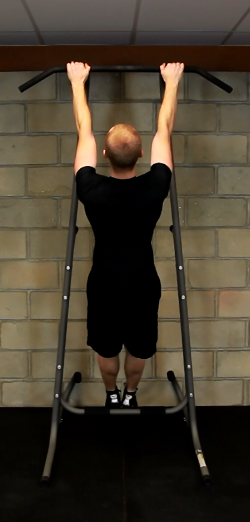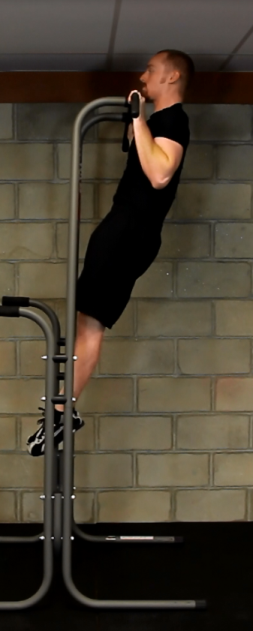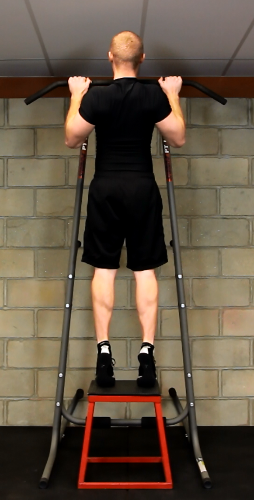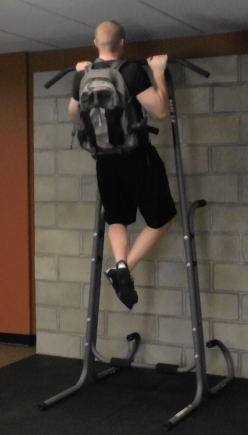How to Enhance Your Pull-up and Chin-up Strength in a Matter of Weeks Without Even Breaking a Sweat by Using a Twist on a Classic Russian Training Method to get Stronger and Rapidly Increase Your Pull-up Numbers
 Over the years, I’ve discovered a number of key components that are essential to pull-up training success, that unfortunately, most people either don’t know about, or at the very least, don’t use, and thus, they perpetually struggle with exercises like pull-ups among others.
Over the years, I’ve discovered a number of key components that are essential to pull-up training success, that unfortunately, most people either don’t know about, or at the very least, don’t use, and thus, they perpetually struggle with exercises like pull-ups among others.
And so, two years ago, I ran an experiment on my website by releasing my very own pull-up training program online – a stripped-down, do-it-yourself version of a general template I had been using with my personal training clients over the years. I wanted to not only provide a great program to my readers, but also to put my unique training methods “out there” for the world at large and see what happens.
I learned a lot of things from this experiment, but one thing that really stood out was that the vast majority of people who used my program dramatically increased their pull-up strength during the first month of the program using a strategy called the Grease the Groove technique (aka GTG), which was popularized in the West by Russian strength coach, Pavel Tsatsouline. And in this article, I’m going to outline a couple of ways you can tweak the GTG technique to maximize your results when using it.
The basic premise behind the GTG technique is to perform an exercise at a sub-maximal effort as often as possible throughout the day for multiple days each week. The goal is to do as many easy repetitions as possible throughout the course of each day, and gradually increase your total daily score over the course of each week and the entire GTG phase. There’s a lot more to it than that, but that’s the GTG technique in a nutshell.
Now, this is a training protocol I had been using for years – both personally, and with my clients – and decided to include it in my program, except I put a unique twist on the Grease the Groove method. Namely, I included some brief instructions on how to self-regulate your intensity level in order to optimize your results, which is one of the many things you can do to increase the potential results from using the traditional GTG technique.
After releasing that beta-version of my pull-up training program almost two and a half years ago, the results started pouring in, and have been trickling in ever since.
Here are a few messages I received from those who have followed the program:
Hi John, When I started I could just about do 1 pull-up. Slightly embarrassing but that was my starting point. ;) At the end of month 1, I can do 5 with proper form. I’m double happy. Thanks for your help, it’s much appreciated. -Dom
I finished month one of the pull ups program 4 days ago. My goal was to do 15 pull ups by the end of the first month–I could do 8 when I started. Today I warmed up with some stretching, and calesthetics. Did a one rep set, and then a 4 rep set of pull ups, then rested. Then I went for a max set–I did 15 good reps, and had my chin within an inch of the bar for a 16th rep. So, I am well satisfied with the progress I made. My goal will be to hit a 20 rep max set by the end of month two. – Norm
Thank you so much for this workout, my pull-ups increased from 3 to 6 in just 1 week. Now i can get better marks at school. I’m 14 and this program works great so far. –Tom
After 4 weeks I definitely made significant progress from where I began doing 2-3 iffy pullups to being able to do 7 complete dead hangs slowly. – Mike
“Current pull-up count is 12…” (one month later) I entered a chin-up contest for fun and did pretty well. I did 19 (really good for me, though they weren’t doing full extension, so I cheated on form as well) and I was running on 4 hours of sleep and was dehydrated, so I’m convinced I could do more! I’m still planning on finishing the 3 month program. – Marcus
So, not only was everyone rapidly increasing their pull-up strength and numbers on this program, but many people got the best results during the first month of the program. And I wanted to get to the bottom of it to see if there was any way to capitalize on those gains.
At first glance, I can think of two main reasons why month 1 of the program was so effective:
1) First, whenever you begin a new exercise program, there is often a phenomenon known as “newbie gains” that results in a dramatic performance improvement simply because of the new stimulus to the body. So, no matter what program you follow, most people will get accelerated results in the beginning, to a degree.
2) And secondly, the Grease the Groove technique is a superb short-term strength training protocol and is particularly effective for maximizing these initial gains for various reasons, especially when the specific application of the GTG has been optimized for not just the exercise to be used, but the person who will be using it. In other words, if you customize and personalize the GTG technique, accelerated results are practically guaranteed.
The Most Important Element of a Pull-up Training Program
Now, in my original pull-up training program, which served as the beta-version of my upcoming pull-up training program (i.e., contained within The Pull-up Solution), I shared just one strategy for personalizing the program to your unique needs, and it was the most important one, and perhaps even the most obvious strategy for optimizing grease the groove: regulating your effort (i.e., exertion level) during your workout sets to better mesh with your conditioning level.
And in this article, I’m going to share one more strategy with you, which is one of many strategies that is included inside of The Pull-up Solution. That strategy revolves around one thing that is particularly important for pull-up training.
Strength.
More specifically, finding the strength “sweet spot” so that you can maximize your gains. Because let’s face it. The pull-up is a strength-dominant exercise. Not endurance, not speed, and not coordination or balance. Strength. Sure, these other conditioning attributes are important and certainly come into play during the pull-up exercise, but strength is the main deciding factor when it comes to pull-up success. And if you don’t focus on getting stronger when pull-up training, then your results will come slowly. Period.
Simply put, strength is almost always the greatest limiting factor when it comes to improving pull-up performance. So, the greatest mistake you can make in pull-up training is to ignore the strength component. And in this article, I’m going to teach you two ways to maximize your strength in the pull-up exercise using a couple strategies that have been seamlessly integrated into The Pull-up Solution.
And here’s the cool part. When you integrate these strategies into a Grease the Groove program for pull-up training, your results will be so much better. So, let’s get to it!
1st Strategy: Select a pull-up exercise that is appropriate to your skill level and will get you into the sweet spot to focus on increasing your strength.
Think about it. If you can barely hold onto the bar – let alone do a single pull-up – then what good is it to tell you to do 3 sets of 10 pull-ups throughout the course of the day? You couldn’t do that if you tried. And similarly, if you can already do 20+ pull-ups, then you’re starting to get into the realm of endurance – not strength. So, even though these are totally different situations, in both cases, we need to find the sweet spot where you’re primarily working on strength. That’s going to require a different approach depending on your conditioning level. And one way to do this is with proper exercise selection, which is particularly important for a difficult bodyweight exercise like pull-ups since you can’t exactly increase or decrease your bodyweight at the drop of a hat.
Beginner Level Pull-up Variations
So, if you’re a beginner, and can barely support your weight while holding onto the bar, then you should try some beginner-level pull-up exercises until you find one that will allow you to perform at least a few to several repetitions, but will also adequately challenge your strength. Here are a few good options…
Deadhang – This exercise involves holding onto a pull-up bar and hanging with the proper tension in the body to activate the musculature involved in the pull-up exercise. There’s a little bit more too it than that (a lot, actually!), but that’s the gist of it. But at its most basic level, you just grab onto a bar and hold on for as long as you can. It’s a good beginner-level isometric exercise for building up to pull-ups and chin-ups.

Flexed-Arm Hang – This is another isometric exercise that involves holding yourself in the top position of the pull-up exercise for as long as possible, and again, while maintaining the proper tension in the body to activate and strengthen the musculature involved in the pull-up exercise. It’s another good stepping stone to full, unassisted pull-ups.

Assisted Repetitions – If you can almost do a full pull-up or chin-up, then performing assisted repetitions might be a good idea. This involves moving through the full range of motion of the pull-up exercise, but using some form of assistance or support to help you throughout each repetition. There are many ways to do them, such as with a partner to help you, using a resistance band, bench, or even jumping to help you get up to the bar each repetition. The key is finding a method that works for you and will tap into the “sweet spot” of strength adaptation.

And there are many more beginner-level and even ultra-beginner-level pull-up exercise variations as well. These are just some of the classic, traditional ones.
Advanced Level Pull-up Variations
Now, if you’re an advanced trainee who can already do 10-15+ pull-ups, for instance, then you might want to consider using an advanced exercise variation, such as…
Weighted Pull-ups (with a weight vest, weight belt, or backpack, etc.) – Adding additional weight to your body is obviously a simple way to increase the strength challenge. It can be done many ways, but the important thing is thing is that it’s not too heavy and will allow you to perform sets in the 3-15ish repetition range – depending on your conditioning level and training goal.

Assisted One-Arm Pull-ups – This is another great advanced exercise for increasing your pull-up strength, and like weighted pull-ups, there are many ways to do it. The key is trying to emphasize one side of the body at a time during your pull-ups reps. This will greatly increase the challenge and the stimulation of the musculature to help increase your strength. Some intermediate trainees can also benefit from this type of pull-up, too.

Plyometric Pull-ups – If you’re at an advanced level and developing not just strength, but speed and power is important to you, then you might want to consider a plyometric pull-up variation, too. Like most pull-up exercises, there are many variations such as clapping pull-ups and reaching pull-ups, among others. The important thing is that you have a very good foundation of proper pull-up technique and a strong work capacity before you begin using plyometric pull-ups. Also, most people should not focus exclusively on plyo-pullups, but may include it with other pull-up variations in a more comprehensive routine.

And again, there are many other advanced pull-up exercises as well – not to mention many more advanced bar exercises that build off of the pull-up exercise that you can work up to (e.g. the muscle up).
Now, you’d think that choosing an appropriate exercise to match your skill level would be common sense, but a lot of people struggle with pull-ups simply because they aren’t using a skill-specific exercise to improve their strength. So, the first strategy is to make sure that the exercise you choose is something that you can not only do, but is going to adequately challenge your strength while greasing the groove.
That’s the general recommendation. Of course, how it’s actually applied will vary from person to person.
2nd Strategy: Incorporate a simple periodization protocol into your Grease the Groove program.
After receiving feedback from many of my beta-testers for The Pull-up Solution, I noticed a trend where the trainees who tended to get the best results from the GTG method performed some form a basic periodization – whether intentionally or not.
And I’m not talking some extremely-complicated formula that you’d need a PhD in Exercise Science to understand – just a very basic progression that anyone can follow once they understand the concept.
Here’s how to do it…
It might help to think of your GTG program as split up into two distinct phases. So, when you first start a GTG program, focus on building volume at a very low intensity/effort level using many low-repetition sets throughout the day (e.g. 10-20 sets of pull-ups per day, if possible). So, in the first week or two of following GTG (i.e., 1st phase), you should focus on increasing the number of sets you perform each day, and thus, the total number of pull-ups you do throughout each day – NOT increasing the intensity/effort level (e.g. trying to do more reps each set).
For example…
Day 1 – 5 sets of 3 = 15 total pull-ups completed during Day 1 of training
Day 2 – 7 sets of 3 = 21 total
Day 3 – 9 sets of 3 = 27 total
Day 4 – 10 sets of 3 = 30 total
Day 5 – 12 sets of 3 = 36 total
Day 6 – 15 sets of 3 = 45 total
Day 7 – 20 sets of 3 = 60 total
So, in this example, the trainee has progressed from performing 15 pull-ups in one day to 60 pull-ups in one day, which is a large increase in training volume, and will result in a large increase in strength – not to mention all the other benefits like better technique, etc.
Now, at some point during the GTG program, a transition should take place where you stop focusing exclusively on building volume, but instead focus on increasing effort/intensity by decreasing the number of sets you perform each day (e.g., 3-8 sets of pull-ups per day). This is where Phase 2 begins.
For example…
Day 21 – 3 sets of 8 = 24 total pull-ups completed during Day 21 of training
Day 22 – 4 sets of 8 = 32 total
Day 23 – 5 sets of 8 = 40 total
Day 24 – 6 sets of 8 = 48 total
Day 25 – 6 sets of 9 = 54 total
Day 26 – 7 sets of 9 = 63 total
Day 27 – 8 sets of 10 = 80 total
Now, I’m not saying this is a good program to follow verbatim, but I hope you understand the concept and can see the transition. During the first part of the GTG program (phase 1), you’re focusing on many low-rep, and low-effort sets. And during the second part of the program (phase 2), you’re focusing on fewer sets of higher-reps and at a higher-effort. And that’s just a very basic periodization model of waving volume and intensity that delivers excellent results when applied to the GTG method.
Summary
So, let’s apply this new knowledge. First, you need to establish the best exercise(s) for your current skill and conditioning level that will challenge you, and more specifically, help you build strength. Generally speaking, that means training with an exercise in the 3 to 15 repetition range depending on your goals and starting point. Secondly, you need to practice that exercise regularly, and the Grease the Groove technique is one of the best methods for doing so. And finally, there needs to be some element of progression to your routine. And I believe following a basic periodization model that waves an increase in volume with an increase in intensity is one of the best ways to maximize your gains with the GTG method.
And if you apply this model to your own GTG pull-up training program, then your results will be much better than if you just “wing it” and hope for the best.
Final Words
Now, here’s the thing: the best program in the world isn’t going to help you unless it is not only customized to your goals, skill level, and conditioning level, but personalized to your everyday needs and circumstances. I mean, what good is a program if it was designed with someone else in mind, or worse yet, you can’t even follow it? Also, what good is a program if it is missing some of the key components that are essential to pull-up training success? Sadly, that’s how most pull-up training programs are. At least, the ones I’ve seen.
And that’s why I’ve integrated all of these components – and many more – into my upcoming pull-up training system to make it as simple and straightforward as possible to rapidly increase your pull-up strength and performance, without compromising your health or risking an injury.
I wanted to create a system that works for practically anyone – regardless or skill or conditioning level – and helps to maximize your results by integrating all of these little details into one holistic system that anyone can use to succeed. Not only that, but I wanted to deliver a system that takes you right to your edge, and no further, each and every time you train to hit the “sweet spot” and make the most of your training sessions by offering a do-it-yourself program that’s as close to having a coach as possible, without actually having one (or having to pay for one).
Click Here to Learn More About The Pull-up Solution
If you found this article helpful, please share it with your friends and tweeps:
.jpg)
![]()
Health-First Fitness Coach
P.S. If you liked this post, then please signup for the newsletter, or follow me on Facebook or Twitter for daily updates and other interesting info.
P.P.S. Photo credit: https://www.flickr.com/photos/99893370@N03/